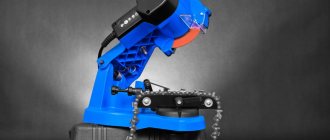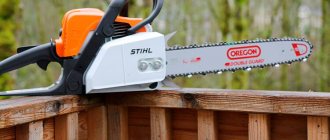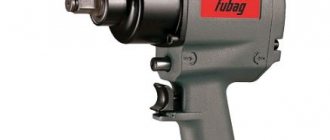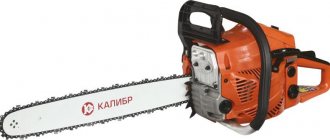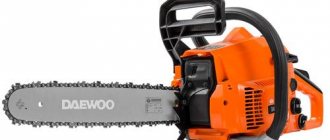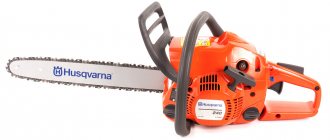External signs of a dull chainsaw tooth
Among the most popular chainsaws are rightfully the tools of the Austrian company Stihl, in particular, Stihl-180 (to be precise, Stihl MS-180-14''). With such a chainsaw you can trim branches and deal with medium-sized branches - a power of 1500 W allows this quite well. Despite the high-quality steel that this brand (we don’t consider Chinese counterfeits!) uses to make the teeth, self-sharpening will require skill and time.
You should pay attention to the following external signs of a dull cutting chain:
- A conical section appeared on the working angle of the tooth.
- When moving from the working corner to the top edge, the radius rounding is visually different.
- At the moment of the initial feed, even at a relatively low intensity, the penetration of the working edge of the tooth into the thickness of the wood is carried out with great resistance.
- At the stage of a steady cut, the chainsaw chain begins to vibrate, and the noise level of the chainsaw increases noticeably.
- When sawing in the longitudinal direction, the cutting surface has rough cuts and chips of wood. The chips themselves become significantly smaller in size.
The trial test is carried out on dead wood, and in no case on wood with high humidity. The frequency of sharpening depends on the main cutting direction. If it is performed predominantly in the axial direction, then sharpening will have to be performed much more often.
Adviсe
For those who are just learning how to sharpen a chainsaw chain themselves, it will be useful to take into account a few basic tips for carrying out this process correctly.
- Whenever manipulating the chain, the engine must be turned off; under no circumstances should you sharpen the chainsaw chain while the saw is running.
- Before sharpening, the chain must be tightened to normal working condition.
- The saw chain brake must be set to the working position when straightening it.
- When sharpening the chain, gloves must be used to protect against cuts from the sharp edges of the teeth.
- Maintaining the same number of file movements is guaranteed to ensure uniform grinding of all teeth.
Below you can see how to sharpen a chainsaw chain with a file in the video; it describes in detail what files you need to use. How to best position the chainsaw. And of course, how should the sharpening tool be positioned in relation to the saw bar.
Finally, I would like to note the main advantages of sharpening with a file, compared to straightening the chain in a machine.
What is included in the sharpening kit?
In the absence of a special machine, you will have to make do with a file to sharpen the chainsaw chain (more precisely, not one, but two). You also need a special template with which you can check the current value of the sharpening angle. Thus, the basic set of sharpening equipment includes:
- Round file with a cross-sectional diameter of 4.5…5 mm.
- A holder with special positioning lines, with the help of which the tool can be placed on the top face with the required accuracy. The holder is equipped with a section that rests on the surface of the cutting depth limiter.
- A flat file used to sharpen the limiter itself.
- A hook that removes sawdust generated during the sharpening process.
It should be noted that manual sharpening is effective only when the signs of dullness of the chainsaw are established very quickly, and the wear is relatively small. Otherwise, more complex and expensive specialized machines will be required. Manual machines in the FUG size range are also suitable for working with Shtil-180 chainsaw teeth. Their advantage is that it is possible to qualitatively sharpen teeth whose wear turned out to be sharply uneven.
Experts advise purchasing sets of such files at the same time as purchasing the saw itself, or, in extreme cases, in the same store. Because there is no universal file for sharpening chainsaws from different manufacturers.
Features of care and maintenance of saw sets
Despite the efficiency, autonomy and other advantages of manual sharpening, experts recommend periodically sharpening chains on special machine equipment. Even a one-time operation has a positive effect on the calibration of cutting links.
On the other hand, mechanized sharpening significantly affects the service life of the saw chain, since all cutting links are subjected to standard processing, regardless of their condition.
- In order to sharpen a chain yourself in the field, you need to have strong skills in working with the existing tool. The best option is to keep several chains in stock that can be changed with minimal loss of working time.
- To properly sharpen the cutting edges of the headset, in addition to a good eye and a steady hand, you need a special sharpening kit, which includes a flat and round file.
In any case, the best result can be obtained by using a branded chain sharpening tool, the capabilities of which are an order of magnitude higher than their cheap analogues.
The practice of working with brand tools shows that the products of leading manufacturers Shtil, Husqvarna, Oregon and a number of others do not differ in quality characteristics.
The service life of removable equipment equally depends on the quality of the material, the design features of the lubrication system, and the qualifications of the workers and maintenance personnel.
During operation, it is recommended to periodically check the tension of the saw chain and the supply of chain oil to the working cutting area. Filling the system with waste and cheap oil substitutes is strictly not recommended.
The wear rate of the chain and bar increases sharply with excessive tension, sand and other abrasive materials getting into the set, or poor condition of the drive sprocket crown. A nail not detected in the wood in a timely manner can ruin a new chain beyond any possibility of repair.
After work, the headset must be cleaned of sawdust; during long breaks in work, it must be dismantled, lubricated and stored in a dry place.
How to choose the right file sizes for sharpening a chain?
The main difficulty is deciding on the size of a round file, because work performed with a flat tool is much simpler. For Stihl saw teeth, the top end of the file should protrude 20% of its height onto the surface of the working angle. However, you should also remember about the saw chain pitch, which is usually taken at 0.325 inches.
The next stage of selection is to clarify the length of the round file. It depends on its size. GOST 1465 establishes five numbers for this tool, but only No. 4 or 5 are suitable as a file for sharpening a chainsaw. Files No. 4 have a working length of 200 mm, and No. 5 - 250 mm and 300 mm. As the length increases, the amplitude of the operator’s hand movements increases, so the quality of guiding the file along the tooth also increases accordingly. Therefore, a longer file is better for sharpening.
In addition to the length, it is important to correctly determine the type of notches available. They can have cut or notched teeth. For sharpening, notched ones are better, because otherwise the cutting angle fluctuates in a wider range of values (70±10 0), which is unacceptable for processing a chainsaw tooth.
Electric and manual sharpening machines
High-quality sharpening of a chain with a file is not always possible during long-term operation of the mechanism without regular maintenance or when the teeth often come into contact with stones and other hard parts of the ground, during which they become significantly deformed and lose their shape. In this case, electric and manual machines are used. The former are equipped with sharpening wheels driven by electric current, while the latter are a type of mechanical device.
The operating principle of manual sharpening machines is reminiscent of a bow-type saw, in which instead of a blade, a round file of the appropriate length is attached. A rather intricate device for mechanical adjustment makes it possible to position the tool with the desired orientation to the smallest control tooth, which is sharpened in several movements.
The sharpening angle parameters are saved when correcting the next cutting element, thus, not only sharpening is carried out quickly and efficiently, but also the chain is straightened to a uniform tooth size. To process the limiter with a manual machine, it is necessary to insert a flat tool instead of a round file.
The use of an electric machine greatly facilitates and simplifies the process of performing work. The sharpening angle on this unit is ensured by a precise adjustment system, which allows you to bring the grinding wheel with a correct orientation directly to the cutting edge of the surface being processed, while the tire is automatically fixed.
Sequence of operations when sharpening
High-quality sharpening of teeth requires strict adherence to the following rules:
- A file for sharpening a chainsaw should be placed strictly perpendicular to the direction of movement of the saw teeth in the vertical direction, and at an angle of 15...20 0 in the horizontal direction. The latter is controlled using a holder.
- The round file in the tooth mouth must be located slightly above its edge (for file No. 5 this is approximately 1...1.5 mm).
- A holder is installed on the tooth, the lines of which will show the exact direction of movement of the file in the horizontal plane.
- After several movements of the file, the sharpening surface is covered with magnetized shavings, which should be immediately removed with a hook.
- Sharpening begins in the direction away from you, without using excessive force: the notches should gently enter the metal of the tooth. It is recommended to make several movements and then turn the file by 20...30 0 so that the wear of the notches occurs more evenly.
- It is recommended to sharpen “through the tooth”: first sharpen the teeth in one direction, and then in the other.
- The pressure on the file during sharpening should be constant, as should the number of reciprocating movements on the tooth being sharpened.
When sharpening the depth limiter, proceed as follows. A template is applied to the limiter. When the stopper slot fits into the template groove, set the height of the worn area, which is removed using a flat file. The template is installed on one of two sides - Hard or Soft, which corresponds to hard or soft wood.
Sharpening will be easier if the chainsaw bar is clamped in a bench vise. The intervals between sharpenings can be increased if you promptly monitor the correct chain tension, monitor the condition of the limiter, regularly lubricate all moving elements, and periodically replace the drive sprocket.
The most inexpensive way to sharpen a saw is to purchase a file for sharpening a chainsaw chain and do it yourself without outside help. However, this scenario implies a lot of nuances. You need to know how to choose a file, what characteristics you should pay attention to, study the sawing technique, and, in the end, be patient, sharp eyesight and steady hands. The last three factors are mandatory, because without them it is impossible to carry out proper sharpening with a file.
Files for sharpening chainsaw chains
Sharpening methods
To sharpen a tool, you can turn to the services of craftsmen who not only know what angle of sharpening chainsaw chains is necessary, but also do all the work quickly and at a professional level. As a rule, the cost of such services is not so high, but the quality, on the contrary, is very high! This option is suitable for those who like to cut wood and have no desire to tinker with their tools.
The round file holder has stripes that allow it to be positioned correctly relative to the chain. The holder is installed on the tooth being sharpened in accordance with the orientation lines. In this case, the plate itself rests on the upper edge of the tooth and the depth stop, and the ratfil is placed under the cutting edge.
The insertion of the holder ensures that the file is attached to the tooth at the correct height. Chainsaw chain sharpening, buy everything for chain sharpening. There are different holders for different pitches of the saw chain. The correct choice of holder, coupled with the correct diameter of the file, ensures that the file protrudes above the back of the tooth by 1/5 of its own diameter. Use only special grinders for sharpening saw chains.
How to choose a file for sharpening a chainsaw chain
Most users are wondering how to choose a file for sharpening a chainsaw chain. The answer to this is complicated, because... implies a lot of options. But the most correct way is to pay attention to the chain pitch. The size (diameter) of the cylindrical file depends on it. But in addition to it, a second one is also required - flat. Two files are used to sharpen different parts of one link. If we look at the process in more detail, a cylindrical file is used to sharpen the saw tooth of the link, namely the end and top blades. Use a flat file to file down the sawing depth limiter. It is important that both files can be purchased as a set with a set of templates and a hook for cleaning the saw and bar from the saw set. Some manufacturers of chainsaws and their electric chain analogues even produce similar kits themselves.
Features of the chainsaw
Cutting wood is similar to working with a plane.
In all this, the size of the cut depends on the thickness of the limiter. When the saw chain works in a saturated mode, the teeth become dull faster. Chain sharpening. File diameter 5 chain file. This is clearly manifested when the ground surface melts in the path of the chain. To blunt the teeth one hundred percent, it is enough to “catch” on the ground for a couple of seconds. If you are able to sharpen it frequently, the chain will last even longer, since very little metal will be removed. In addition to the question of what angle of sharpening the chainsaw chain should be, you also need to know this!
There is no need to work with blunt equipment for a number of reasons. At first, this affects the quality of the cut, but not for the best. Lethargy also quickly sets in, which is felt not only in the hands, but also in the body.
Another reason. unjustified excessive consumption of fuel. All parts will work in increased mode, which inevitably leads to rapid wear. Performance drops seriously, which also happens when using a defective chain.
To be able to sharpen a chainsaw chain perfectly, you should know the structure of its teeth. You can’t do without knowing the sharpening angle. Each tooth has a complex structure. Its geometry is represented by the following components:
- basis;
- spatula;
- depth limiter.
With all this, the blade consists of two blades: the end blade and the top blade. At the same time, there must be the correct sharpening angle of the chainsaw chain between them in order to provide it with the required performance.
How can you figure it out now? It is not the chain that cuts the tree, since it serves as the basis for securing the cutting links and moves them at the highest speed. The links themselves have sharp blades, with the help of which the wood is cut.
File diameter for sharpening chainsaw chain
The diameter of the file for sharpening a chainsaw chain is very important in the process of selecting a tool. An incorrectly selected file will damage the chain, causing problems during the sawing process. The saw can get stuck inside the tree, break off and cause damage to an expensive tool. The diameter directly depends on the chain pitch. When sharpening, 4 main diameter sizes are used, corresponding to their pitch: • ¼” pitch – diameter 4.0 mm; • Pitch 0.325″ - 4.8 mm; • Pitch 3/8″ - 5.2 mm; • Pitch 0.404″ - 5.5 mm. For some types of chains, files with a diameter of 3.2 mm are also used.
How much does a chain cost and which one to choose?
To choose the right chain for your chainsaw, pay attention to the following factors:
- Select the part in accordance with the model, power and characteristics of the chainsaw.
- Consider the intensity of work and service life.
- Compare the brand of the unit and the compliance of parts from other manufacturers.
- Consider the pitch of the saw set and the sharpening angle of the cutting tooth.
- Pay attention to the length of the bar and the dimensions of the chain.
It is difficult to understand which chain is better. Much depends on the material being sawed, the manner and nature of the work, and the cutting method.
For moderate use, purchase a product with a 0.325-inch pitch; for heavy loads, a 3/8-inch pitch is suitable. Based on the sharpening angle, for a high level of load on the tool, choose a part with a sharpening of 30°, for increased use and processing of damp, frozen wood - an angle of 10°.
The cost also depends on these factors. The price of chains for Shtil chainsaws starts from 500 rubles, depending on the characteristics and purpose.
For professional use, emergency rescue operations, and cutting metal reinforcement and concrete, carbide-coated cutting elements are used. Pobedit chain for chainsaws has a long service life and is used on saws with high-power motors.
The Swiss company Stihl is one of the leading in the world. Choose quality tools and components. Don't forget about safety precautions.
Files for sharpening chainsaw chains Stihl Stihl
There are various files on the market for sharpening Stihl chainsaw chains. Despite the external differences, they are all branded. Some of them are accessories for sharpening machines and are sold in packs of several pieces. They do not have handles, so they are difficult to use without a base. Files sold individually can be included in a set or sold independently. There are 2 options – with and without a sharpening template. In addition to files, Shtil also produces a number of auxiliary devices: • filing gauges; • mandrels for sharpening; • templates (holders) of different types; • clamps. Filing gauges are designed to check sharpening depth, clean grooves and check corners manually. The mandrel is a plate with guides printed on it, indicating the sharpening angle of the link. By moving in accordance with the guides it is easier to maintain the correct degree of angle. It is attached using magnets to a metal busbar. The clamp works on the principle of a holder and allows you to sharpen the cutting and limiting teeth of the link in one step.
Files for sharpening chainsaw chains Stihl
Alternative options
The Russian market has a wide range of auxiliary equipment that allows you to select a file or device for sharpening chains of different configurations and price levels. The products of leading manufacturers of chainsaw equipment are of the best quality.
A significant part of the offers consists of branded components for various models of sharpening machines. Such files do not have shanks or handles, so they are not suitable for manual sharpening. Piece products may be sold individually or as a set with templates, mandrels, holders or other additional equipment.
Proper sharpening of a chainsaw chain with a file
It is easiest to start sharpening directly on the bar, but some manufacturers oppose this, citing various arguments, and recommend removing the chain from the device and securing it in a vice. But this is extremely inconvenient, because... After sharpening each link, the chain must be dismantled and reinstalled.
If, however, the chain is sharpened directly on the saw, the bar can move while suspended under the pressure of a hand with a file, so it is necessary to install a stop for the bar on the opposite edge, for example, a block of wood. It is important to clean the chain from any remaining sawdust, grease and debris before sharpening. This will make the job easier.
Proper sharpening of a saw chain with a file
Begin sharpening from the most ground tooth. It is by this that all others will be aligned. If a tooth is broken, it must be replaced by riveting the chain with a special machine and installing a new element of the appropriate size and type. After the element is selected, sharpening begins. The file is moved straight away from you along the semicircular edge of the sawing tooth, resting the template against the edge of the adjacent chain link. In this case, it is necessary to maintain parallelism between the file and the plane of the surface on which the saw or vice is installed, as well as the angle of the guide indicated on the plate template. Thus, all links of the chain are processed one by one, i.e. only those that are on one side of it. Upon completion, they move to the other half of the links and perform the same operation, but at the opposite angle, also indicated on the guide in the template. After completion, the file for sharpening the chainsaw chain is set aside, and the chain is brushed with a brush, removing metal shavings.
A properly sharpened chainsaw chain is one of the keys to successful and productive sawing. A well-sharpened chain does not create unnecessary loads on the saw, easily overcomes the natural resistance of wood and requires less lubrication, and also lasts longer.
You can sharpen the chain by taking it to a sharpening point (this is usually either in a key-making workshop or in specialized stores). In addition, you can sharpen a saw chain yourself, having some skills and knowledge.
There are two ways to sharpen your chainsaw chain yourself:
- Using a chain sharpener
- Using a special file
I already wrote about chain sharpening machines: Chain sharpening machine: is it necessary and how to choose? Today we’ll talk about chain files.
Manual sharpening machine
This method is not suitable for every chain; if the cutting edge has lost its shape, then sharpening is very difficult and requires a tremendous amount of effort and energy. Then it is easier to use a chain sharpening machine. There are two main types of machines, manual and electrically powered, equipped with a sharpening stone or a wheel. This is a clearer and more accurate method that will suit everyone in any situation.
Let's start by loosening the clamp in the chain. After this, we will correctly install the chainsaw chain, so that the links are directed towards the sharpening stone. Next, most importantly, in order not to spoil all the work, we select the correct angle at which the sharpening will take place.
Several sharpening methods:
- Alternate - each tooth can be processed separately and alternately, one by one (with all this changing the polarity)
- Sharpening of every second cutter - on the right, and later on the left side, you choose the sequence yourself. The polarity does not change with this technique.
When choosing a method of sharpening with a manual machine, you should know certain aspects that must be observed:
- Finding out the rational level of chain sharpening, depending on the blunt tooth as the head guide
- The chain cannot be ground deeply, then the strength and power are reduced, as well as the operating time of the chainsaw.
- It is better to use compressed air after sharpening to blow off any excess. After this, leave the device to rest for a couple of hours.
- It is simply impossible to find a more precise method, but, unfortunately, this is work that requires a lot of time and effort.
Chain file
You need to understand that you won’t be able to sharpen a chain with an ordinary round file, much less a flat or triangular file, since a file for a chain must have its own parameters. Although it’s worth making a note here - you can sharpen the depth limiter with a simple flat file.
File parameters for chain sharpening
The most important parameter of a file for sharpening a chain is its diameter. It is important because, depending on the pitch of the chain, a file of a certain diameter is used. Below is a table showing which file is suitable for a chain with a particular pitch.
Sadko SCS-85 Pro
A Ukrainian trademark specializing in the production of gardening equipment, the market offers several models of sharpening devices. The SCS-85 Pro version is classified as a professional version. At the same time, consumers note that the power of the unit is only 85 W, and the speed is 5 thousand revolutions per minute.
The advantages include discs with an abrasive coating with a diameter of 10.4/2.2 cm, a weight of 2.5 kilograms, the presence of a key for quick adjustment of work in depth and a lock for reverse movement of the chain.
Useful tips
Some helpful tips will help keep your equipment in working order and eliminate the risk of injury. In addition to the question of what angle of sharpening the chainsaw chain should be, you should also know this! Of course, it is necessary to know the correct angle of sharpening the chain of the Shtil chainsaw. But timely tire care is also important:
- It is necessary to control the chain tension. Especially if the chainsaw tilts to one side during operation. Poor tension can pose a threat to humans.
- Conduct sharpening in a timely manner, without putting everything on the back burner. It may be expensive, but it is better to give preference to electrical equipment.
- Regularly lubricate the entire chain, otherwise it may fly off (its speed is about 100 km/h). Everyone will draw their own conclusions.
- Do not use used motor oil or any product of questionable quality. You should only choose specialized lubricants. The most important parameter of a file for sharpening a chain is the diameter of the file. As the best remedy - autol.
Before you start using a chainsaw, the chain should be broken in. Let it run at minimum speed for 40-50 seconds. The lubricant will reach every part, and the chains with the sprocket will heat up a little and rub against each other.
All this expert advice should not be ignored if you want to remain safe and sound!


